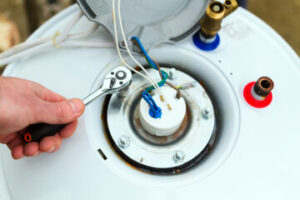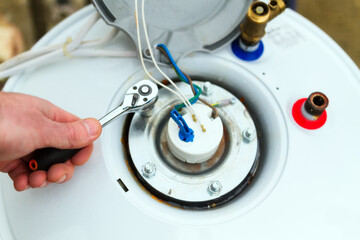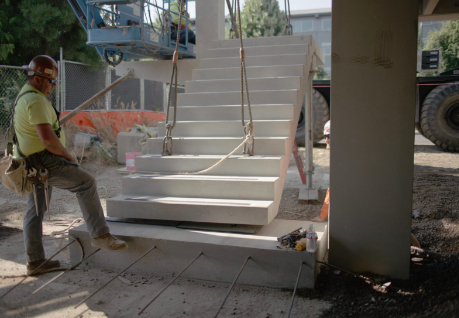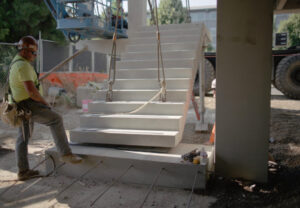Water heaters play a critical role in the comfort of your home. If you notice an issue, such as a lack of hot water or puddles around the unit, it’s time to call Water Heater Repair Denver.
First, make sure the circuit breaker is on and hasn’t tripped. Then, check the upper and lower heating elements.
The upper and lower thermostats on a water heater are responsible for heating up your water. If either of them go out, your hot water may not be as hot as usual. There are several causes of this, including a lack of electrical power (blown fuses or circuit breaker), a broken heating element, or a thermostat that isn’t working properly. If you suspect that your thermostat is the problem, you can try to troubleshoot it yourself.
The first thing you should do is check that the breaker isn’t tripped, and that the high-temperature limit switch isn’t popped. These switches prevent your water from getting too hot and protect you from scalding accidents. If they keep tripping, it’s a sign that something is wrong with your water heater and should be looked at by a professional.
If the breaker is fine, you can test the lower thermostat with your multimeter. You’ll need to disconnect power from the unit, and you’ll also need to remove the access panel on both the top and bottom of the tank. Be careful, as these panels contain live wires that are exposed when the cover is removed. Once you’ve disconnected the power, use a voltmeter to measure the resistance of the runner wires connected to the thermostat. If the resistance is less than 1 ohm, the thermostat is defective.
If it isn’t, you can relight the pilot light. You should only attempt this if you have the owner’s manual and are familiar with the safety precautions. If you aren’t familiar with the safe operation of gas water heaters, have a professional take a look at it for you. They can also repair or replace the thermocouple and gas control valve, both of which could be causing your problems. It’s important to find out exactly what is causing the problem so that you can make a decision about how to proceed. If your water heater is over 10 years old, a replacement may be the best option. If it is under 7, it’s worth trying to get it repaired by a Carter plumber.
Sediment in the Tank
Sediment buildup is a common problem with water heaters that have tanks. The sediment comes from minerals and particulates in your well or municipal water supply. Over time, it builds up in the tank and affects how your water looks and tastes. Eventually, it can cause your hot water heater to make odd noises and shorten its lifespan.
If you notice that your water has a rusty look or smells bad, it’s an indication of excessive sediment in your tank. It also makes it difficult for the hot water to heat properly and can contribute to higher energy bills.
Fortunately, sediment is easy to diagnose and fix with a few simple steps. Start by turning off the power to your water heater. Then drain the water heater by opening the valve and placing a bucket under the plastic relief valve drain pipe. This will help keep water from escaping during the draining process. Next, turn on your cold water supply. The resulting churning action will loosen more sediment and flush it out of the tank.
After draining the tank, turn off your water heater’s breaker or gas burner and let it cool down. Then, you can start the process over by turning on the water again and draining it once more. Repeat this process as needed until the sediment is gone from your tank.
If you have a gas water heater, you may hear unusual sounds coming from the unit while it’s heating up. These sounds are caused by air pockets that are trapped under the sediment layer and burn when heated up. The sounds are similar to hissing or sizzling.
Lastly, a metallic taste or scent in your water is another sign of excessive sediment in the tank. The bacteria in the sediment can corrode elements in your water heater and cause it to fail prematurely. In addition, the oxidized metals can discolor your water and give it a bad taste or smell. The odor can be prevented by using a magnesium rod in your tank to attract the bacterial and metals, but this rod will dissolve over time and must be replaced periodically.
Moisture on or Around the Unit
When a hot water heater is operating properly, excess moisture is supposed to drip from the top of the unit into a drain pan or to a safety float switch that shuts off the system. If there’s a leak or other problem, however, the water may leak around the bottom of the tank or out a vent pipe and onto the floor of the home. This is a major problem and one that often requires a professional plumber.
Another clue that something is wrong with your water heater is that the hot water smells odd or is discolored. This could be a sign that the tank is rusty or that there are other problems with your hot water supply, such as a faulty dip tube or sacrificial anode rod.
If you see puddles or pools of water near the water heater, turn off the power and cold water supply at the service panel. If there’s still no hot water, it could be because the breaker is constantly tripping or that the temperature and pressure relief valve is malfunctioning.
This valve should be tested at least once per year and replaced every five years to prevent over-pressurization of the tank. To test the valve, place a bucket under the drain pipe to catch the water and remove the plastic cap from the pressure relief valve on the side of the tank. Open the valve and relieve the pressure by turning the handle clockwise. When the water is no longer leaking, replace the cap and screw the valve into place.
You may also need to check the insulation around the vent pipe and ensure that there isn’t any damage or that it’s properly sealed. Keep flammable or combustible items away from the heater as well, as it’s possible to create a fire hazard if something goes wrong with the unit.
Leaks are a sure sign that your water heater is reaching the end of its useful life and may soon need to be replaced. If you have a corroded tank or other issues that can’t be repaired, turn off the water and call your local plumbing company to discuss replacement options.
Leaks
A water heater leak isn’t just annoying, it’s dangerous. It’s a fire hazard and it could cause water damage to your home. It’s also a safety hazard for your family as the leaking water could create a scalding hazard. It’s important to have any water leakage dealt with as soon as you see it. This way, you can prevent serious and costly damage to your home and your possessions.
The first step to take when a water heater leaks is to shut off the power and the water supply to the unit. Next, it’s important to find the source of the leak. This may be as simple as tightening connections that have come loose due to normal wear and tear, or it could mean replacing the entire water heater tank. In some cases, it’s best to have a professional inspect the unit and determine what caused the leak before taking action.
If a puddle forms near your water heater, it is likely that the tank is leaking. If this is the case, you’ll need a plumber to replace it with a new one. If the puddle is in a different area, it could be a symptom of other problems, such as rust or sediment.
Another sign of a water heater leak is rusty water coming from the unit. This usually indicates that the anode rod has become corroded and needs to be replaced as soon as possible to prevent further damage.
Leaks from the top of the tank often indicate a broken temperature and pressure relief valve, or it could be due to a faulty drain valve or a damaged expansion tank. Lastly, a leak from the bottom of the tank can be caused by a cracked or rusty lining in the tank or loose pipe fittings that need to be tightened or replaced.
A final issue that may indicate it’s time to get a new water heater is if the unit is over ten years old and has begun to leak. While it’s not impossible to fix a leak from an older water heater, the costs of repairs and replacement can become quite high over time, so if you are considering investing in a new unit, now is a good time to do so.


